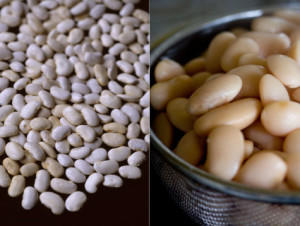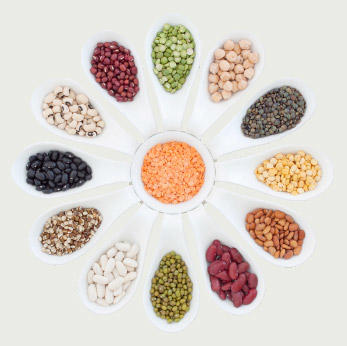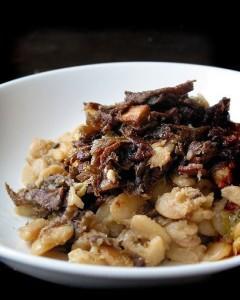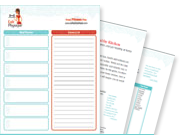As discussed in Part 1, beans are excellent source of protein, dietary fiber and complex carbohydrates. They’re also quite inexpensive and versatile for whipping up flavorful, healthy meals. But what exactly are you supposed to do with a bag of beans?
Bean Cookin’ 101 (courtesy of Whole Foods):
 I know, I know. Cooking dried beans takes more time than opening a can, but you’ll be richly rewarded with superior flavor and texture. They’re a superb value too! Here’s how:
I know, I know. Cooking dried beans takes more time than opening a can, but you’ll be richly rewarded with superior flavor and texture. They’re a superb value too! Here’s how:
- Sort: Arrange dried beans on a sheet pan or clean kitchen towel and sort through them to pick out any shriveled or broken beans, stones or debris. (Take our word for it; running your fingers through the beans in the bag doesn’t work the same.)
- Rinse: Rinse the sorted beans well in cold, running water.
- Soak: Soaking beans before cooking helps to remove some of those indigestible sugars that cause flatulence. There are two simple ways to get the job done:
- Regular soak: Put beans into a large bowl and cover with 2 to 3 inches of cool, clean water. Set aside at room temperature for 8 hours or overnight; drain well. (If it’s really warm in your kitchen, soak the beans in the refrigerator instead to avoid fermentation.)
- Quick soak: Put beans into a large pot and cover with 2 to 3 inches of cool, clean water. Bring to a boil then boil briskly for 2 to 3 minutes. Cover and set aside off of the heat for 1 hour; drain well.
- Cook: Put beans into a large pot and cover with 2 inches of water or stock. (Don’t add salt at this point since that slows the beans’ softening.) Slowly bring to a boil, skimming off any foam on the surface. Reduce heat, cover and simmer, stirring occasionally and adding more liquid if necessary, until beans are tender when mashed or pierced with a fork. Cooking times vary with the variety, age and size of beans; generally you’re looking at about 1 to 2 hours.
Beans tend to absorb the flavors of the ingredients with which they are cooked. However, take care to ensure that these added foods only increase flavor and do not hinder texture development. Follow these tips when adding each of these ingredients to beans to make them delicious and nutritious:
- Acid: Adding sources of acid is a great way to increase the depth of flavor in bean dishes. Add foods such as lemon juice, vinegar, tomatoes, chili sauce, ketchup, molasses or wine after beans have been cooked fully. These acidic foods can prevent beans from becoming tender and lengthen cooking time if they are added too soon.
- Onions: Adding onions also can increase the depth of flavor in beans. Add onions any time during the cooking process, but for a stronger onion flavor, add during the last 30 minutes of cooking.
- Herbs and spices: Add oregano, thyme, garlic, parsley or any other herbs/spices any time during cooking. However, keep in mind that flavors of herbs and spices tend to diminish the longer they are cooked.
- Salt: Add when the beans are almost tender because salt tends to toughen beans. Remember to use minimal amounts of salt to limit the sodium content of beans.
And now for the good part! Here are the links to my favorite sites for getting consistently delicious, easy-to-make bean-centric dishes, along with my top recommendations from each:
- The Bean Institute – Try breakfast for dinner with the Black Bean Omelet with Avocado Salsa Verde
- Whole Foods – Stock up on your superfoods with the Warm Heirloom Bean, Squash, and Kale Salad
- The Kitchn – Check out the Florida Butter Beans with Caramelized Onions and Bacon (This is seriously scrumptious!)
- Eating Well – Search for the Sweet Potato and Black Bean Chili recipe (BTW, this is one of my favorite sites for getting any recipes, in general.)
* I linked to the general bean recipe pages on these sites, so you can just search for my recommended recipes if you’re interested in starting with those.



